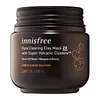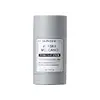What's inside
What's inside
 Key Ingredients
Key Ingredients

 Benefits
Benefits

 Concerns
Concerns

 Ingredients Side-by-side
Ingredients Side-by-side

Water
Skin ConditioningCI 77891
Cosmetic ColorantButylene Glycol
HumectantSilica
AbrasiveGlycerin
HumectantTrehalose
HumectantVolcanic Ash
AbrasivePolyvinyl Alcohol
Bentonite
AbsorbentKaolin
AbrasiveCaprylic/Capric Triglyceride
MaskingGlyceryl Stearate
EmollientStearic Acid
CleansingCetearyl Alcohol
EmollientPvp
Emulsion Stabilising1,2-Hexanediol
Skin ConditioningPEG-100 Stearate
Polysorbate 60
EmulsifyingCI 77499
Cosmetic ColorantHydrogenated Vegetable Oil
EmollientXanthan Gum
EmulsifyingJuglans Regia Shell Powder
AbrasiveSorbitan Stearate
EmulsifyingZea Mays Starch
AbsorbentPolyacrylate-13
Polysorbate 20
EmulsifyingCI 77492
Cosmetic ColorantMannitol
HumectantMicrocrystalline Cellulose
AbsorbentLactic Acid/Glycolic Acid Copolymer
Skin ConditioningLactic Acid
BufferingPolyisobutene
CI 77491
Cosmetic ColorantMenthoxypropanediol
MaskingTetrasodium Pyrophosphate
BufferingDisodium EDTA
Ethylhexylglycerin
Skin ConditioningSorbitan Isostearate
EmulsifyingAluminum Hydroxide
EmollientTriethoxycaprylylsilane
Tocopherol
AntioxidantWater, CI 77891, Butylene Glycol, Silica, Glycerin, Trehalose, Volcanic Ash, Polyvinyl Alcohol, Bentonite, Kaolin, Caprylic/Capric Triglyceride, Glyceryl Stearate, Stearic Acid, Cetearyl Alcohol, Pvp, 1,2-Hexanediol, PEG-100 Stearate, Polysorbate 60, CI 77499, Hydrogenated Vegetable Oil, Xanthan Gum, Juglans Regia Shell Powder, Sorbitan Stearate, Zea Mays Starch, Polyacrylate-13, Polysorbate 20, CI 77492, Mannitol, Microcrystalline Cellulose, Lactic Acid/Glycolic Acid Copolymer, Lactic Acid, Polyisobutene, CI 77491, Menthoxypropanediol, Tetrasodium Pyrophosphate, Disodium EDTA, Ethylhexylglycerin, Sorbitan Isostearate, Aluminum Hydroxide, Triethoxycaprylylsilane, Tocopherol
Water
Skin ConditioningKaolin
AbrasiveGlycerin
HumectantVolcanic Soil
Skin ConditioningManicouagan Clay
AbsorbentStearic Acid
CleansingGlycolic Acid
BufferingBifida Ferment Filtrate
Skin ConditioningSaccharomyces/Barley Seed Ferment Filtrate
HumectantSaccharomyces/Mother Of Pearl Ferment Lysate Filtrate
Skin ConditioningLactobacillus Ferment Lysate
Skin ConditioningLactobacillus/Soymilk Ferment Filtrate
Skin ConditioningCaprylic/Capric Triglyceride
MaskingCollagen
MoisturisingPentylene Glycol
Skin ConditioningSimmondsia Chinensis Seed Oil
EmollientSodium Hydroxide
BufferingCI 77499
Cosmetic ColorantDipropylene Glycol
HumectantGlyceryl Stearate
EmollientDipotassium Glycyrrhizate
HumectantBisabolol
MaskingCeteth-25
CleansingPhenoxyethanol
PreservativeMenthone Glycerin Acetal
RefreshingPEG-100 Stearate
Butylene Glycol
HumectantHectorite
AbsorbentPEG-8
HumectantXanthan Gum
EmulsifyingSorbitan Isostearate
EmulsifyingCitrus Reticulata Fruit Extract
Skin ProtectingPhytic Acid
Disodium Stearoyl Glutamate
CleansingAluminum Hydroxide
EmollientPaeonia Suffruticosa Extract
Skin ConditioningMichelia Alba Flower Extract
Skin ConditioningScutellaria Baicalensis Extract
AntimicrobialCI 77891
Cosmetic ColorantPolysorbate 20
EmulsifyingTitanium Dioxide
Cosmetic ColorantCeramide AP
Skin Conditioning1,2-Hexanediol
Skin ConditioningHydroxyacetophenone
AntioxidantLeuconostoc/Radish Root Ferment Filtrate
AntimicrobialParfum
MaskingPopulus Tremuloides Bark Extract
AntiseborrhoeicPropylene Glycol
HumectantEthylhexylglycerin
Skin ConditioningWater, Kaolin, Glycerin, Volcanic Soil, Manicouagan Clay, Stearic Acid, Glycolic Acid, Bifida Ferment Filtrate, Saccharomyces/Barley Seed Ferment Filtrate, Saccharomyces/Mother Of Pearl Ferment Lysate Filtrate, Lactobacillus Ferment Lysate, Lactobacillus/Soymilk Ferment Filtrate, Caprylic/Capric Triglyceride, Collagen, Pentylene Glycol, Simmondsia Chinensis Seed Oil, Sodium Hydroxide, CI 77499, Dipropylene Glycol, Glyceryl Stearate, Dipotassium Glycyrrhizate, Bisabolol, Ceteth-25, Phenoxyethanol, Menthone Glycerin Acetal, PEG-100 Stearate, Butylene Glycol, Hectorite, PEG-8, Xanthan Gum, Sorbitan Isostearate, Citrus Reticulata Fruit Extract, Phytic Acid, Disodium Stearoyl Glutamate, Aluminum Hydroxide, Paeonia Suffruticosa Extract, Michelia Alba Flower Extract, Scutellaria Baicalensis Extract, CI 77891, Polysorbate 20, Titanium Dioxide, Ceramide AP, 1,2-Hexanediol, Hydroxyacetophenone, Leuconostoc/Radish Root Ferment Filtrate, Parfum, Populus Tremuloides Bark Extract, Propylene Glycol, Ethylhexylglycerin
 Reviews
Reviews

Ingredients Explained
These ingredients are found in both products.
Ingredients higher up in an ingredient list are typically present in a larger amount.
1,2-Hexanediol is a synthetic liquid and another multi-functional powerhouse.
It is a:
- Humectant, drawing moisture into the skin
- Emollient, helping to soften skin
- Solvent, dispersing and stabilizing formulas
- Preservative booster, enhancing the antimicrobial activity of other preservatives
Aluminum Hydroxide is a form of aluminum. It can be naturally found in nature as the mineral gibbsite. In cosmetics, Aluminum Hydroxide is used as a colorant, pH adjuster, and absorbent.
As a colorant, Aluminum Hydroxide may add opacity, or reduce the transparency. Aluminum hydroxide is contains both basic and acidic properties.
According to manufacturers, this ingredient is an emollient and humectant. This means it helps hydrate the skin.
In medicine, this ingredient is used to help relieve heartburn and help heal ulcers.
There is currently no credible scientific evidence linking aluminum hydroxide in cosmetics to increased cancer risk.
Major health organizations allow the use of aluminum hydroxide in personal care products and have not flagged it as a carcinogenic risk at typical usage levels.
Learn more about Aluminum HydroxideButylene Glycol (or BG) is used within cosmetic products for a few different reasons:
Overall, Butylene Glycol is a safe and well-rounded ingredient that works well with other ingredients.
Though this ingredient works well with most skin types, some people with sensitive skin may experience a reaction such as allergic rashes, closed comedones, or itchiness.
Learn more about Butylene GlycolThis ingredient is an emollient, solvent, and texture enhancer. It is considered a skin-softener by helping the skin prevent moisture loss.
It helps thicken a product's formula and makes it easier to spread by dissolving clumping compounds.
Caprylic Triglyceride is made by combining glycerin with coconut oil, forming a clear liquid.
While there is an assumption Caprylic Triglyceride can clog pores due to it being derived from coconut oil, there is no research supporting this.
Learn more about Caprylic/Capric TriglycerideCi 77499 is also hydrated iron III oxide. It is created from mixing red and black iron oxides. This helps give shades of darkness to a product.
Iron III oxides are classified as inorganic chemicals for coloring.
Ci 77891 is a white pigment from Titanium dioxide. It is naturally found in minerals such as rutile and ilmenite.
It's main function is to add a white color to cosmetics. It can also be mixed with other colors to create different shades.
Ci 77891 is commonly found in sunscreens due to its ability to block UV rays.
Learn more about CI 77891Ethylhexylglycerin (we can't pronounce this either) is commonly used as a preservative and skin softener. It is derived from glyceryl.
You might see Ethylhexylglycerin often paired with other preservatives such as phenoxyethanol. Ethylhexylglycerin has been found to increase the effectiveness of these other preservatives.
Glycerin is already naturally found in your skin. It helps moisturize and protect your skin.
A study from 2016 found glycerin to be more effective as a humectant than AHAs and hyaluronic acid.
As a humectant, it helps the skin stay hydrated by pulling moisture to your skin. The low molecular weight of glycerin allows it to pull moisture into the deeper layers of your skin.
Hydrated skin improves your skin barrier; Your skin barrier helps protect against irritants and bacteria.
Glycerin has also been found to have antimicrobial and antiviral properties. Due to these properties, glycerin is often used in wound and burn treatments.
In cosmetics, glycerin is usually derived from plants such as soybean or palm. However, it can also be sourced from animals, such as tallow or animal fat.
This ingredient is organic, colorless, odorless, and non-toxic.
Glycerin is the name for this ingredient in American English. British English uses Glycerol/Glycerine.
Learn more about GlycerinGlyceryl Stearate is a mix of glycerin and stearic acid.
It is used to stabilize the mixing of water and oil ingredients. By preventing these ingredients from separating, it can help elongate shelf life. It can also help thicken the product's texture.
As an emollient, it helps soften skin and supports barrier-replenishing ingredients.
In cosmetics, Glyceryl Stearate is often made from vegetable oils or synthetically produced.
This ingredient may not be fungal-acne safe
Fun fact: The human body also creates Glyceryl Stearate naturally.
Learn more about Glyceryl StearateKaolin is a clay. It is used for oil control and to help minimize pores. Like other clays, kaolin has the ability to absorb excess sebum or oil. This can help clean out pores and mattify the skin.
Some types of kaolin may have exfoliating properties. When water is added to kaolin, it becomes a paste with small abrasive particles.
Most kaolin is a white color, but may be pink/orange/red depending on where it comes from.
The name 'kaolin' comes from a Chinese village named 'Gaoling'. Kaolin clay comes from rocks rich in kaolinite. Kaolinite, the mineral, has a silicate layered structure. Kaolinite is formed from chemical weathering of aluminum siilicate minerals.
Besides skincare, kaolin is commonly used to make glossy paper, in ceramics, toothpaste, and as medicine to soothe stomach issues.
Learn more about KaolinPeg-100 Stearate is an emollient and emulsifier. As an emollient, it helps keep skin soft by trapping moisture in. On the other hand, emulsifiers help prevent oil and water from separating in a product.
PEGS are a hydrophilic polyether compound . There are 100 ethylene oxide monomers in Peg-100 Stearate. Peg-100 Stearate is polyethylene glycol ester of stearic acid.
Polysorbate 20 is made by combining ethoxylation of sorbitan, ethylene oxide, and lauric acid. It is a mild cleansing agent, surfactant, and emulsifier.
As a surfactant, it helps collect dirt and oils for washing. Emulsifiers prevent oils and water from separating.
Polysorbate 20 also adds scent to a product. Since it is made using sorbitol, it has a sweet scent. Sorbitol can also be found in fruits such as apples and peaches.
The lauric acid used to create Polysorbate 20 is often derived from coconuts.
Polysorbate 20 may not be fungal acne safe.
Learn more about Polysorbate 20Sorbitan Isostearate is an emulsifer and cleaning agent. It is created from isostearic acid and sorbitol.
As an emulsifier, Sorbitan Isostearate prevents oils and water from separating.
Due to its isostearic acid base, it may not be safe for Malassezia or fungal acne.
Learn more about Sorbitan IsostearateStearic Acid is a fatty acid. It is an emollient, emulsifier, and texture enhancer.
As an emollient, stearic acid helps soften skin. It aids the skin's protective barrier by preventing water loss. It also provides a gentle cleansing effect without stripping away natural oils.
Stearic acid may also be used to enhance the texture of products. It can add volume and stabilize ingredients such as water and oil. This can help water and oil ingredients from separating.
Sources of stearic acid include animal or vegetable fats/oils such as coconut or shea. It can be naturally found in butter, cocoa butter, shea butter, vegetable fats, and animal tallow.
This ingredient may not be Malassezia folliculitis, or fungal-acne safe.
Learn more about Stearic AcidWater. It's the most common cosmetic ingredient of all. You'll usually see it at the top of ingredient lists, meaning that it makes up the largest part of the product.
So why is it so popular? Water most often acts as a solvent - this means that it helps dissolve other ingredients into the formulation.
You'll also recognize water as that liquid we all need to stay alive. If you see this, drink a glass of water. Stay hydrated!
Learn more about WaterXanthan gum is used as a stabilizer and thickener within cosmetic products. It helps give products a sticky, thick feeling - preventing them from being too runny.
On the technical side of things, xanthan gum is a polysaccharide - a combination consisting of multiple sugar molecules bonded together.
Xanthan gum is a pretty common and great ingredient. It is a natural, non-toxic, non-irritating ingredient that is also commonly used in food products.
Learn more about Xanthan Gum